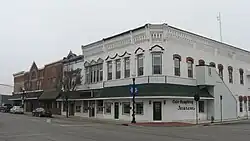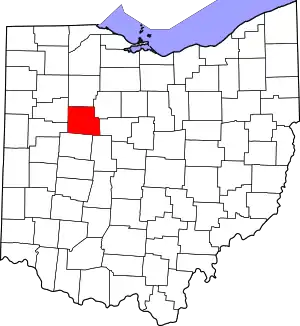Ada, Ohio | |
|---|---|
 Corner of Main Street and Buckeye Avenue in Ada | |
| Nickname: “A Classic Ohio Village” | |
 Location of Ada, Ohio | |
 Location of Ada in Hardin County | |
| Coordinates: 40°46′8″N 83°49′20″W / 40.76889°N 83.82222°W | |
| Country | United States |
| State | Ohio |
| County | Hardin |
| Township | Liberty |
| Government | |
| • Mayor | Dave Retterer |
| Area | |
| • Total | 2.13 sq mi (5.53 km2) |
| • Land | 2.13 sq mi (5.53 km2) |
| • Water | 0.00 sq mi (0.00 km2) |
| Elevation | 958 ft (292 m) |
| Population (2020) | |
| • Total | 5,334 |
| • Density | 2,499.53/sq mi (965.30/km2) |
| Time zone | UTC-5 (Eastern (EST)) |
| • Summer (DST) | UTC-4 (EDT) |
| ZIP code | 45810 |
| Area code | 419 |
| FIPS code | 39-00198[3] |
| GNIS feature ID | 1064295[2] |
| Website | www |
Ada (/ˈeɪdə/ AY-də[4]) is a village in Hardin County, Ohio, United States, located about 69 miles (111 km) southwest of Toledo. The population was 5,334 at the 2020 census. It is the home of Ohio Northern University.
History
Following the 1817 Treaty of Fort Meigs, the Shawnee Indians held reservation land at Hog Creek near Ada. Ada itself was originally called Johnstown, platted in 1853 by S. M. Johnson when the railroad was extended to that point.[5] When a post office was established it was called Ada Post Office, named after the postmaster's daughter, Ada.[6][7] The post office has been in operation since 1854.[8] Ada has been noted for having one of the shortest place names in Ohio.[9] The National Arbor Day Foundation has qualified Ada as a Tree City USA since 1981.
Geography
Ada is located at 40°46′8″N 83°49′20″W / 40.76889°N 83.82222°W (40.768883, -83.822298).[10]
According to the 2010 census, the village has a total area of 2.08 square miles (5.4 km2), all land.[11] The area surrounding the village is mostly farmland and small plots of forest. Hog Creek is the only waterway of note and snakes around the village to the north and the east.
Demographics
| Census | Pop. | Note | %± |
|---|---|---|---|
| 1880 | 1,760 | — | |
| 1890 | 2,079 | 18.1% | |
| 1900 | 2,576 | 23.9% | |
| 1910 | 2,465 | −4.3% | |
| 1920 | 2,321 | −5.8% | |
| 1930 | 2,499 | 7.7% | |
| 1940 | 2,368 | −5.2% | |
| 1950 | 3,640 | 53.7% | |
| 1960 | 3,918 | 7.6% | |
| 1970 | 5,309 | 35.5% | |
| 1980 | 5,669 | 6.8% | |
| 1990 | 5,413 | −4.5% | |
| 2000 | 5,582 | 3.1% | |
| 2010 | 5,952 | 6.6% | |
| 2020 | 5,334 | −10.4% | |
| 2021 (est.) | 5,256 | −1.5% | |
| Sources:[3][12][13][14][15][16][17] | |||
2010 census
As of the census[18] of 2010, there were 5,952 people, 1,729 households, and 846 families living in the village. The population density was 2,861.5 inhabitants per square mile (1,104.8/km2). There were 1,910 housing units at an average density of 918.3 per square mile (354.6/km2). The racial makeup of the village was 93.5% White, 1.9% African American, 0.1% Native American, 1.9% Asian, 0.7% from other races, and 1.9% from two or more races. Hispanic or Latino of any race were 1.6% of the population.
There were 1,729 households, of which 24.7% had children under the age of 18 living with them, 37.7% were married couples living together, 8.2% had a female householder with no spouse present, 3.1% had a male householder with no spouse present, and 51.1% were non-families. 38.0% of all households were made up of individuals, and 8.5% had someone living alone who was 65 years of age or older. The average household size was 2.26 and the average family size was 3.01.
The median age in the village was 22.2 years. 13.6% of residents were under the age of 18; 49.5% were between the ages of 18 and 24; 17.2% were from 25 to 44; 13.5% were from 45 to 64; and 6.3% were 65 years of age or older. The gender makeup of the village was 50.8% male and 49.2% female.
2000 census
As of the census[3] of 2000, there were 5,582 people, 1,783 households, and 850 families living in the village. The population density was 2,982.7 inhabitants per square mile (1,151.6/km2). There were 1,948 housing units at an average density of 1,040.9 per square mile (401.9/km2). The racial makeup of the village was 95.50% White, 1.58% African American, 0.13% Native American, 1.25% Asian, 0.30% from other races, and 1.24% from two or more races. Hispanic or Latino of any race were 0.59% of the population.
There were 1,783 households, out of which 22.9% had children under the age of 18 living with them, 37.6% were married couples living together, 7.3% had a female householder with no spouse present, and 52.3% were non-families. 36.6% of all households were made up of individuals, and 9.0% had someone living alone who was 65 years of age or older. The average household size was 2.22 and the average family size was 2.92.
In the village, the population was spread out, with 13.9% under the age of 18, 48.6% from 18 to 24, 18.0% from 25 to 44, 12.5% from 45 to 64, and 7.1% who were 65 years of age or older. The median age was 22 years. For every 100 females, there were 96.1 males. For every 100 females age 18 and over, there were 94.4 males.
The median income for a household in the village was $24,665, and the median income for a family was $39,300. Males had a median income of $32,143 versus $23,750 for females. The per capita income for the village was $12,561. About 11.7% of families and 21.9% of the population were below the poverty line, including 10.9% of those under age 18 and 19.4% of those age 65 or over.
Economy
The Wilson Sporting Goods NFL football manufacturing facility is located in Ada, and is the only leather football manufacturing facility in the United States.[19]
Education
Ada Exempted Village Public School houses grades K-12 and most of the administration.[20] The district spends $7,701 per student annually ($925 lower than the state average).[21] Ada High School's sports teams participate in the Northwest Conference.
Ada is the home of Ohio Northern University, a private university comprising five colleges.[22]
Media
Three media outlets currently operate in Ada. The Ada Herald is a weekly newspaper, AdaIcon.com is a news website, and WOHA, a non-commercial, religious radio station owned by Holy Family Communications. This station was formerly WONB, an independent, non-commercial radio station run by Ohio Northern University until it was sold in 2020. WONB exists online as a live-stream service.
Transportation

Ada Airport (FAA LID: 0D7) is a privately owned, public-use airport located 1 nautical mile (1.9 km; 1.2 mi) northwest of the central business district of Ada. Ada station formerly operated along the Pennsylvania Railroad and is listed on the National Register of Historic Places.[23]
Notable people
- John Berton, computer graphics animator
- Zac Dysert, American football player
- Rollo May, an existential psychologist
- Carey Orr, cartoonist
- Lee Tressel, College Football Hall of Famer, father of former Ohio State University football coach Jim Tressel
References
- ↑ "ArcGIS REST Services Directory". United States Census Bureau. Retrieved September 20, 2022.
- 1 2 "US Board on Geographic Names". United States Geological Survey. October 25, 2007. Retrieved January 31, 2008.
- 1 2 3 "U.S. Census website". United States Census Bureau. Retrieved January 31, 2008.
- ↑ "E.W. Scripps School of Journalism Ohio Pronunciation Guide | Ohio University". www.ohio.edu. Ohio University. 2016. Retrieved January 2, 2024.
- ↑ Kohler, Minnie Ichler (1910). A Twentieth Century History of Hardin County, Ohio: A Narrative Account of Its Historical Progress, Its People and Principal Interests. Lewis Publishing Company. p. 197.
- ↑ The History of Hardin County, Ohio. Warner Beers & Company. 1883. p. 734.
- ↑ Overman, William Daniel (1958). Ohio Town Names. Akron, OH: Atlantic Press. p. 1.
- ↑ "Hardin County". Jim Forte Postal History. Retrieved December 14, 2015.
- ↑ Wolfe, Don (December 3, 1985). "One More Letter And Ai May Be Put Onto Map". Toledo Blade. p. 17. Retrieved May 21, 2015.
- ↑ "US Gazetteer files: 2010, 2000, and 1990". United States Census Bureau. February 12, 2011. Retrieved April 23, 2011.
- ↑ "2010 Census U.S. Gazetteer Files for Places – Ohio". United States Census. Archived from the original on March 2, 2018. Retrieved October 19, 2012.
- ↑ "Population of Civil Divisions Less than Counties" (PDF). Statistics of the Population of the United States at the Tenth Census. U.S. Census Bureau. 1880. Retrieved November 28, 2013.
- ↑ "Population: Ohio" (PDF). 1910 U.S. Census. U.S. Census Bureau. Retrieved November 28, 2013.
- ↑ "Population: Ohio" (PDF). 1930 US Census. U.S. Census Bureau. Retrieved November 28, 2013.
- ↑ "Number of Inhabitants: Ohio" (PDF). 18th Census of the United States. U.S. Census Bureau. 1960. Retrieved April 24, 2020.
- ↑ "Ohio: Population and Housing Unit Counts" (PDF). U.S. Census Bureau. Retrieved November 22, 2013.
- ↑ "QuickFacts Ada village, Ohio". census.gov. Retrieved June 28, 2022.
- ↑ "U.S. Census website". United States Census Bureau. Retrieved January 6, 2013.
- ↑ Thomas, Katie (February 2, 2008). "At a Small Ohio Factory, Leather and Laces Mesh". The New York Times. Retrieved September 2, 2008.
- ↑ "Home - Ada Exempted Village Schools". www.ada.k12.oh.us.
- ↑ "Ada High School (2021-22 Ranking) | Ada, OH".
- ↑ "Ohio Northern University". Ohio Northern University. Retrieved May 7, 2012.
- ↑ "National Register Information System". National Register of Historic Places. National Park Service. March 13, 2009.
